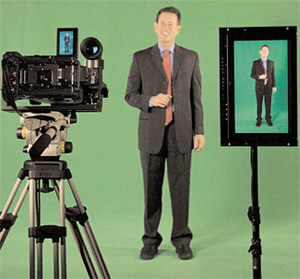Spider's Ringo Puts Camera On Its Side

Mike Peters
WASHINGTON
Like a lot of us in this profession, I'm finding that more and more of my shooting is being done in high definition. I enjoy working with the sharper image and the 16:9 aspect ratio. High-definition video also provides the opportunity for my clients to use more effects, and that often means shooting more green screen.
My goal when shooting green screen is to light and lens the subject to match the backplate that it will be keyed over, thus providing the editor with the cleanest possible key.
Many of the subjects that I've shot have been talking heads. When this type of shooting was done in standard def, I had 480 lines of vertical resolution with which the editor could work.
Once we moved to high definition, I could provide either 720p or 1080-line video. Other factors may affect the key quality, such as color space and compression algorithms, but such an increase in the resolution has really proven to be a big step forward.
LOOKING AT THE SUBJECT IN A DIFFERENT WAY
If you look at a person being framed from head-to-toe in any HD format you'll notice a lot of unused video space on the left and/or right of the subject. I discovered that this is really some very valuable video resolution real estate.
Just suppose we take our video camera and turn it 90 degrees off axis and then frame our subject from head-to-toe. With this simple camera rotation, we're able to maximize this video real estate even more and can obtain 1920 lines of vertical high-definition resolution to use in cutting the key. This is four times the resolution of our original standard-definition key source, and almost twice that resulting from a normally shot horizontal HD image.
I started doing this for many green screen shoots and received high praise from the editors I was working with. They appreciated the increased resolution around the subject, as it gave them much cleaner keys.
This technique has proven useful in other ways too, as I've also used it to shoot many programs that were eventually put on vertically mounted high-definition video displays in museums.
The challenge in both of these situations is to be able to mount the HD camera when it's turned 90 degrees from its usual working position, and to do so in a safe and convenient manner.

The Spider Support Systems' Ringo Head allows for a full 90 degree camera tilt. I created some rather unusual do-it-yourself contraptions that sort of worked, but the camera balance was never perfect. When it came time to change tapes and/or batteries, my Rube Goldberg mounting technique proved to be far from convenient. And to be honest, the mount also didn't look very professional. I really needed to find a better way of mounting cameras at the desired 90-degree angle.
READY-MADE ANSWER
After some Web searching, I stumbled onto Spider Support Systems. I soon learned that this company had perfected an awesome vertical camera mount—the Ringo Head. It really does a great job in making vertical shooting easier, as it allows an operator to position any professional video camera in a vertical orientation.
The Ringo Head also has multiple threaded tripod plate holes to allow a perfect balance to be achieved. I've found that the unit works with all of my small format cameras, large video cameras, and even the RED One camera. Most importantly, any camera mounted is really quite secure—unlike the situation with an improvised mounting rig.
I did a vertical green screen shoot the very next day after receiving my unit. Both the client and I were very impressed.
The Ringo Head is not a tool that I need everyday, but when I do need to shoot green screen or a feature that will be displayed in a vertical orientation it is a huge help.
Mike V. Peters is a 26 year veteran in the television production industry. He is an award winning director/director of photography, and is also creative director of MVP Pictureworks, a Washington D.C.-based production company. He may be contacted at mvpeters@mac.com.
For additional information, contact Spider Support Systems at 703-758-0699 or visitwww.spidersupport.com.
Get the TV Tech Newsletter
The professional video industry's #1 source for news, trends and product and tech information. Sign up below.
